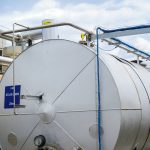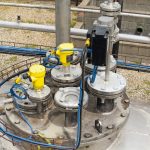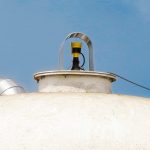Firmen im Artikel
Croda Ibérica manufactures by-products in large quantities for the Spanish and Portuguese markets at its site in Fogars de la Selva, a municipality in the province of Barcelona. The company has been working with Vega Spain for more than ten years now and when it comes to level instrumentation, relies completely on the Spanish subsidiary of the level and pressure specialist from Schiltach, Germany. About 200 sensors belonging to different product families are installed there including guided radar sensors, various limit detectors for liquids and solids as well as pressure and differential pressure transmitters. As a special feature of the measuring points, all of these Vega instruments and sensors are Atex-certified. The only level measuring point without a Vega sensor is a reactor where temperatures of more than 300 °C are the norm. A weighing system is used there instead.
High transmitter frequency
The Vegapuls 64 radar level measuring sensor launched in the market in 2016 is one of the instruments installed at the site, where it measures a mixture of special detergent formulations and alcohols very efficiently. The raw material supplies are first of all measured in three tanks with a height of two, three and five metres. The results of these measurements are critical for further processing because the end product accounts for about a quarter of the factory’s entire output.
Since absolutely reliable measurements are crucial for the customer, the costs associated with this measuring point were invariably high. Differential pressure transducers were used originally, but the deposits which accumulated clogged up the piping. Croda Ibérica then switched over to guided radar measurements but the structure of the tank with its built-in pipes led to heavy deposits on the inserted rod probe.
It wasn’t only the medium, and its tendency to settle on the tank wall and installations, that was the cause of inaccuracies; the heating coils and pipework in the
reactor influenced the measuring signals. The problems at the measuring point
could only be solved after installing a
Vegapuls 64, which operates at a high frequency of 80 GHz (as opposed to 26 GHz previously).
Since the Vegapuls 64 measures without contact using radar technology, there are automatically fewer problems with product deposits. The measuring technology is also ideal from a hygiene point of view. The front-flush, encapsulated antenna, for example, can be cleaned optimally and is insensitive to the extreme conditions of the SIP and CIP processes.
The Vegapuls 64 is similarly insensitive to deposits and the formation of condensation despite its shorter wavelength. This is mainly achieved by adapting the sensitivity in the sensor’s near range. This dynamic, distance-dependent adaptation reduces the impact of interference directly in front of the antenna system and at the same time enables very high signal sensitivity at longer distances. A reliable level measurement is therefore also possible during cleaning cycles.
Fewer interference signals
The structure of the tank with its complex installations likewise no longer has any influence on the measurement. The focussing of the radar measuring instrument, which depends on the transmitter frequency and the effective antenna surface area, was improved with this aim in mind. Conversely, however, this also means that the three times higher transmitter frequency permits smaller antenna sizes without any deterioration in signal focussing. Much smaller process connections are now possible with an antenna size of just ¾“ – no bigger than a one-euro coin.
This new antenna version helped to reduce the interference signals in the near range significantly. Since the antenna system was integrated into the process connection, it no longer protrudes into the tank, so it is possible to measure reliably all the way to the process connection. The tank capacity can therefore be utilised more efficiently and more flexibly.
Right down to the bottom
Another positive aspect has become apparent in the meantime, which Croda Ibérica did not have in mind initially but which turned out to be extremely important in practice: using the Vegapuls 64, it is possible to measure right down to the bottom of the tank even with totally different media. This is important considering the fact that the tank must be completely emptied every two weeks.
It should be mentioned here that, with media with low relative permittivity, some of the signals penetrate the medium and
are reflected on the bottom of the tank. This results in two different signals: the actual liquid level and the tank bottom. The signals from the tank bottom are larger and the lower the relative permittivity of the medium and the better the tank reflects (e.g. a flat metal bottom). Due to the much shorter wavelength of the Vegapuls 64’s 80 GHz signals, the latter are damped in the medium to a far greater extent than with 26 GHz sensors. There is therefore much less reflection from the bottom of the tank. The upshot of all this is that measurements right down to the bottom of the tank are substantially easier than with the sensors
previously used.
Fast commissioning
Although the structure of the tank was very complex, the conversion and installation of the Vegapuls 64 were completed very fast. Since the existing process connection could be used, installing the new sensor was a simple matter.
This procedure has already proven effective in other applications in the pharmaceutical and cosmetics industries. The plant has usually undergone acceptance testing and constructional modifications are only possible later at great expense. The thread sizes can be adapted, e.g. to fit clamp connections. Other process connections are available for aseptic areas in which PTFE is the only wetted material. These connections meet the requirements of 3-A and EHEDG.
The learning curve was very short because the Vegapuls 64 works with the proven plics concept. The Plicscom display and operating module which is used to commission and operate the sensors also indicates the measured values on-site. No PC or special software is required. The Plicscom module can be inserted into and removed from the sensor at any time without interrupting the power supply. Wireless Bluetooth communication was introduced in 2016. This is particularly interesting for points that are difficult to access, rugged industrial environments or hazardous areas. The module is downward-compatible and can be used for the entire installed base of plics sensors in pressure and level applications – with 70 different instrument types, no software updates and the proven operating structure. Users can thus configure and parametrise their plics sensors from a safe distance using a smartphone or tablet, either Apple or Android. Display and diagnostic functions are likewise available. All that Croda Ibérica’s maintenance team had to do was install the sensors.
Reliable measured values
In addition to the reliable measurements, Croda Ibérica particularly values the professional knowledge of the dedicated Vega technician, who for many years now has
responded promptly to calls and had a solution to hand even for unforeseen incidents. Despite the proven technology, Croda Ibérica is very interested in innovative level instrumentation solutions owing to the importance of these parameters. The company therefore did not hesitate for long when the Vegapuls 64 came onto the market. The new sensors were installed four months ago and have been supplying reliable results ever since.
Online search: cpp0118vega















